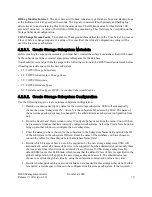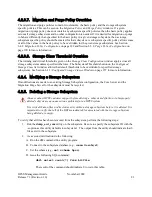
Field Descriptions
Server Name.
A unique descriptive name given to the server. Ensure that the Server Name is unique. A
server’s descriptive name should be meaningful to local site administrators and operators, in contrast to
the server’s corresponding UUID, which has meaning for HPSS. For HPSS systems with multiple
subsystems it is very helpful to append the subsystem ID to the Server Name of subsystem-specific
servers. For instance, “Core Server 1” for the Core Server in subsystem 1.
Before modifying this field, check whether this server is using the default log policy or its own custom
log policy (see Section 5.1.1.1:
Log Policy
on page 95). If the server is using its own custom log policy,
modify it to use the default log policy. Skipping this step will cause an extraneous log policy to remain in
the system.
Server ID.
A UUID that identifies a server to HPSS. A unique value is automatically generated and
displayed for new servers. While you are permitted to modify this field by hand, such a practice is not
recommended because of the danger that you could type in a UUID which is not unique within the entire
HPSS realm. This field may only be modified in Add mode.
Server Type.
The type of the HPSS Server.
Server Subtype.
The subtype of the selected server. This field is only used by the PVR servers to specify
the type of PVR (e.g. STK).
Storage Subsystem.
Name of the HPSS Storage Subsystem to which this server is assigned. This field is
required for the Core Server and Migration/Purge Server. For all other servers this field is not displayed.
The following rules apply to this field:
•
The Storage Subsystem Configuration must exist before configuring Core Servers or
Migration/Purge Servers.
•
Core Servers and Migration/Purge Servers must have a valid storage subsystem set in this field
before SSM will allow the server configuration to be created.
•
No more than one Core Server and one Migration/Purge Server can be assigned to any one
subsystem.
•
This field can only be modified in Add mode.
5.1.1.1. Execution Controls
The Execution Controls section of the
Server Configuration
window is common to all servers. In the
example window above, the server displayed is a Core Server.
Field Descriptions
Execute Pathname.
The UNIX file system path name to a server’s executable image file. This file must
reside on the node specified by
Execute Hostname.
Use the full UNIX path name; otherwise, the Startup
Daemon will try to start the file out of the current working directory of the Startup Daemon.
HPSS Management Guide
November 2009
Release 7.3 (Revision 1.0)
90
Summary of Contents for RELEASE 7.3
Page 14: ...HPSS Management Guide November 2009 Release 7 3 Revision 1 0 14...
Page 195: ...HPSS Management Guide November 2009 Release 7 3 Revision 1 0 195...
Page 210: ...HPSS Management Guide November 2009 Release 7 3 Revision 1 0 210...
Page 215: ...HPSS Management Guide November 2009 Release 7 3 Revision 1 0 215...
Page 222: ...HPSS Management Guide November 2009 Release 7 3 Revision 1 0 222...
Page 266: ...HPSS Management Guide November 2009 Release 7 3 Revision 1 0 266...
Page 293: ...HPSS Management Guide November 2009 Release 7 3 Revision 1 0 293...
Page 367: ...HPSS Management Guide November 2009 Release 7 3 Revision 1 0 367...
Page 372: ...HPSS Management Guide November 2009 Release 7 3 Revision 1 0 372...
Page 384: ...HPSS Management Guide November 2009 Release 7 3 Revision 1 0 384...
Page 388: ...HPSS Management Guide November 2009 Release 7 3 Revision 1 0 388...
















































